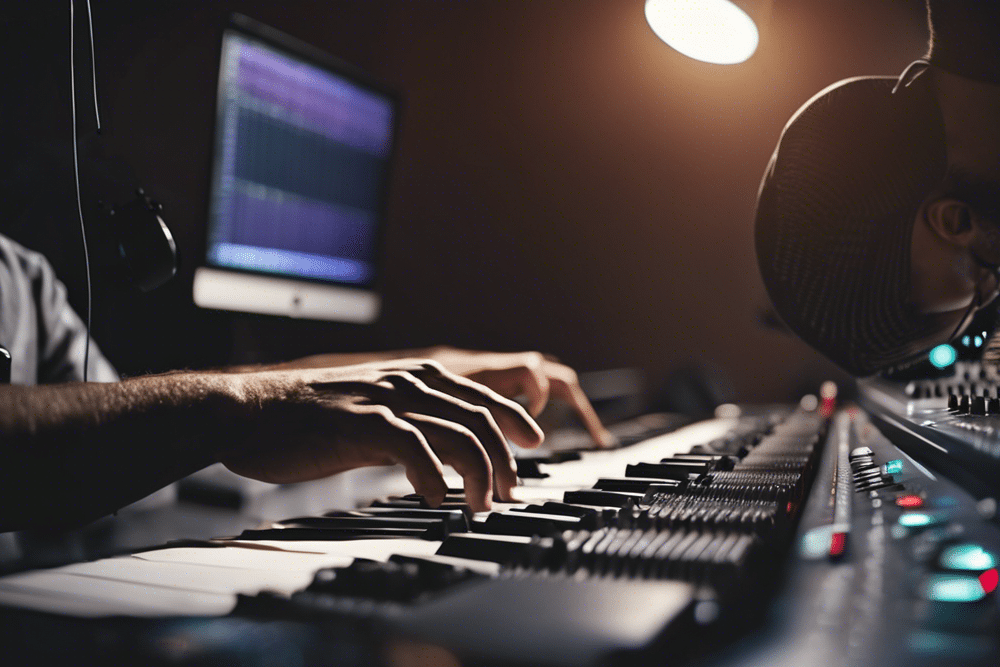Estimated reading time: 7 minutes
Introduction: The Power of Loops in Music Production
As a music producer, you’ve likely encountered the term “loops” countless times. But what exactly are loops, and why are they so crucial in modern music production? In this comprehensive guide, we’ll explore the world of loops, from their basic definition to advanced techniques for creating and using them in your music. Whether you’re a beginner just starting out or an experienced producer looking to refine your skills, this article will provide valuable insights into how to make loops that elevate your music to new heights.
Table of contents
- Introduction: The Power of Loops in Music Production
- Understanding Loops: The Building Blocks of Modern Music
- Getting Started: How to Make Loops
- Advanced Loop-Making Techniques
- Loop Libraries and Resources
- Integrating Loops into Your Productions
- Common Challenges and Solutions
- Conclusion: Embracing Loops in Your Music Production Journey
- FAQs
Understanding Loops: The Building Blocks of Modern Music
What Are Loops?
At its core, a loop is a short section of audio that repeats seamlessly. These musical snippets can be anything from a simple drum beat to a complex melodic phrase. Loops serve as the foundation for many genres of music, especially in electronic and hip-hop productions.
The Role of Loops in Music Production
Loops have revolutionized the way we create music. They offer several advantages:
- Time-saving: Producers can quickly lay down the basic structure of a track.
- Inspiration: Loops can spark creativity and help overcome writer’s block.
- Consistency: They provide a steady rhythmic or melodic foundation.
- Versatility: Loops can be manipulated and combined in countless ways.
Getting Started: How to Make Loops
Choosing Your Tools
Before diving into loop creation, you’ll need to select the right tools. Many digital audio workstations (DAWs) come with built-in loop-making capabilities. Some popular options include:
These software packages often include loop libraries and loop-making tools to get you started.
Creating Drum Loops
Drum loops are perhaps the most common type of loop. Here’s a basic process to create one:
- Set your tempo and time signature.
- Create a new MIDI track.
- Use your DAW’s drum machine or load a drum kit.
- Program your beats using the piano roll or step sequencer.
- Experiment with different patterns and rhythms.
- Adjust the velocity of each hit for a more natural sound.
- Add effects like compression or reverb to taste.
Pro Tip: Start with a simple kick and snare pattern, then gradually add hi-hats and other percussion elements to build complexity.
Crafting Melodic Loops
Melodic loops add harmonic interest to your tracks. Here’s how to create one:
- Choose an instrument (e.g., piano, synth, or guitar).
- Decide on a chord progression.
- Play or program a melody that complements the chords.
- Experiment with different note lengths and rhythms.
- Add subtle variations to keep the loop interesting.
- Apply effects like delay or chorus to enhance the sound.

Bassline Loops
A solid bassline can drive your track forward. To create a bassline loop:
- Select a bass instrument (synth or sampled).
- Focus on the root notes of your chord progression.
- Experiment with different rhythmic patterns.
- Play with note duration (short and punchy vs. long and sustained).
- Consider using slides or pitch bends for added interest.
Advanced Loop-Making Techniques
Sampling and Chopping
Sampling is a powerful technique for creating unique loops:
- Find an interesting section of an existing song or sound.
- Import it into your DAW.
- Use your DAW’s slicing tool to chop the sample into smaller pieces.
- Rearrange these pieces to create a new loop.
- Experiment with pitch-shifting and time-stretching for added creativity.
Remember: Always ensure you have the rights to use any samples in your music to avoid copyright issues.
Layering Loops
Combining multiple loops can create rich, complex textures:
- Start with a basic drum loop.
- Add a bassline loop that complements the rhythm.
- Layer in melodic or harmonic loops.
- Experiment with muting and unmuting different layers.
- Use EQ to carve out space for each loop in the frequency spectrum.
Creating Variation
To keep your loops from becoming repetitive:
- Use automation to gradually introduce or remove elements.
- Apply different effects at various points in the loop.
- Create multiple versions of the loop with slight variations.
- Use your DAW’s randomization features to add subtle changes.
Loop Libraries and Resources
While creating your own loops is rewarding, sometimes you need inspiration or a quick starting point. Many producers use loop libraries as a foundation for their tracks. Here are some popular options:
- Splice: Offers a vast collection of royalty-free loops across various genres.
- Loopmaster: Provides high-quality loops and samples from top producers.
- Native Instruments: Offers loop libraries as part of their Maschine and Komplete software.
- Apple Loops: Included with Logic Pro and GarageBand, offering a wide range of built-in loops.
- VIPZONE SAMPLES: Provides high-quality loops and sample packs.
When using pre-made loops, consider these tips:
- Customize the loops to make them your own.
- Combine multiple loops to create something unique.
- Use loops as inspiration, then recreate them with your own instruments.

Integrating Loops into Your Productions
Now that you know how to make loops, let’s explore how to effectively use them in your music:
Building the Foundation
- Start with a drum loop to establish the rhythm and tempo.
- Layer in a bassline loop to provide harmonic context.
- Add melodic loops to create the main theme or hook.
Arrangement and Structure
Use loops to define different sections of your track:
- Intro: Gradually introduce elements of your main loop.
- Verse: Use stripped-back versions of your loops.
- Chorus: Layer multiple loops for a fuller sound.
- Bridge: Introduce new loops or variations for contrast.
- Outro: Gradually remove elements of your loops.
Adding Live Elements
To make your loop-based track more dynamic:
- Record live instruments over your loops.
- Add vocal recordings or rap lines.
- Use a drum pad controller to trigger and manipulate loops in real-time.
Common Challenges and Solutions
Loops Sound Repetitive
Solution: Use automation, effects, and subtle variations to keep loops interesting. Don’t be afraid to break the loop occasionally.
Loops Don’t Fit Together
Solution: Use your DAW’s warping or time-stretching features to adjust the tempo and rhythm of loops. Pay attention to the key and scale of melodic loops.
Overreliance on Loops
Solution: Use loops as a starting point, then build upon them with your own ideas. Gradually replace loop elements with your own recordings or MIDI programming.
Conclusion: Embracing Loops in Your Music Production Journey
Learning how to make loops is an essential skill for modern music producers. From crafting basic drum patterns to creating complex, layered arrangements, loops offer endless possibilities for creativity and expression. Remember, the key to effective loop-based production is balance – use loops to inspire and support your music, but don’t let them limit your creativity.
As you continue to explore the world of loop-making, keep experimenting with different techniques, instruments, and styles. Listen to a wide variety of music to discover new loop ideas, and don’t be afraid to push the boundaries of what’s possible with loops in your chosen genre.
Whether you’re creating electronic dance anthems, laid-back hip-hop beats, or experimental soundscapes, mastering the art of making and using loops will undoubtedly elevate your music production skills. So fire up your DAW, start crafting some loops, and let your creativity flow. Happy producing!
Related Posts
FAQs
Loops are short, repeating audio sections, like drum beats or melodies, that seamlessly play on a loop. They serve as the building blocks in many genres of music, particularly in electronic and hip-hop, providing a consistent foundation for tracks.
Loops save time by quickly building the structure of a track, inspire creativity by sparking new ideas, offer consistency in rhythmic or melodic patterns, and allow for endless manipulation and variation to suit different styles.
To create loops, you’ll need a digital audio workstation (DAW) like Ableton Live, FL Studio, or Logic Pro. These programs come with loop-making tools and libraries, making it easier to start crafting drum, melodic, or bassline loops.
To avoid repetitiveness, apply effects like reverb or automation, introduce variations, or layer multiple loops together. Using small adjustments, such as changing note velocities or rhythm, can keep your loops fresh and engaging.
Yes, many producers use pre-made loops from libraries like Splice or Loopmaster. However, it’s recommended to customize them, combine multiple loops, or recreate them with your own instruments to give your track a unique sound.
